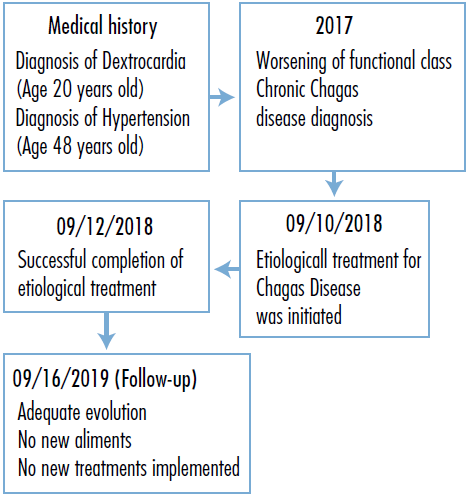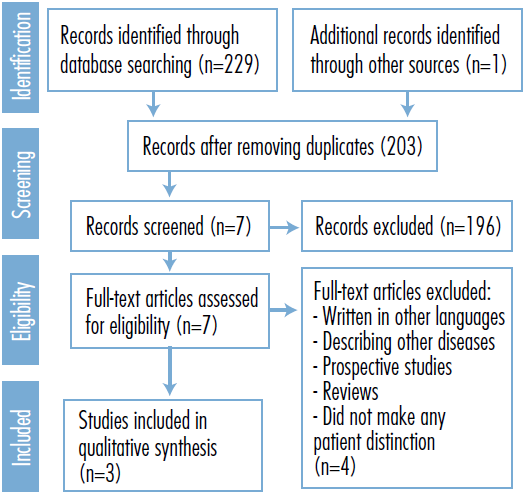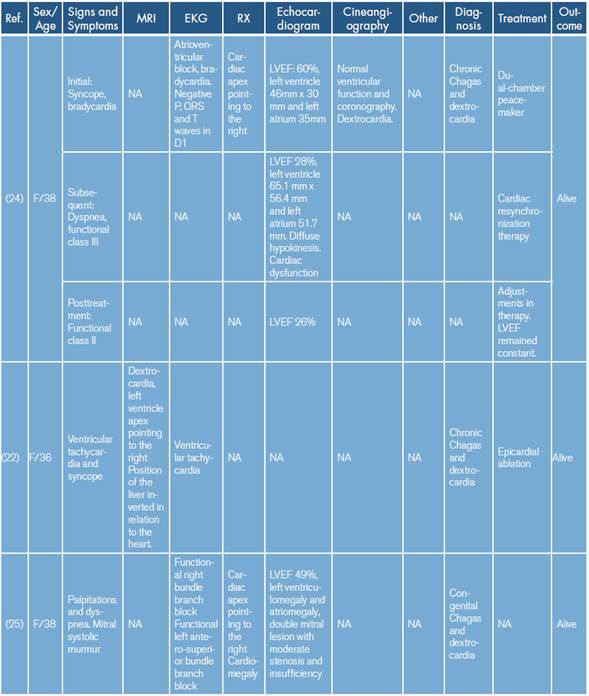INTRODUCTION
At least 4.8 million people in Colombia are at risk of contracting Chagas disease, and almost half a million are currently infected 1. Several meta-analyses recently estimated the prevalence of the disease with a range between 2-4% 2,3. Unfortunately, according to the consolidated information from the data published in the 201 6 epidemiological weeks and data from the public health surveillance system, screening tests have not been widely performed and between 2008 and 2015, only 65 000 tests were performed among the population at risk, representing only 1.35% of that population. Of the taken tests, approximately 10% were positive 4.
Furthermore, according to data consolidated and provided by the Red Nacional de Bancos de Sangre (Colombian National Blood Network in internal conferences) in 2016 and based on information from the public health system, the network tested over 5 million blood units in 2014 and 2015 and less than 10% were positive. However, in 2018, this national network confirmed that 10% of total donors in 2016 tested positive for molecular markers of Chagas disease 5. Regardless, this is not a representative sample because most blood units were collected from major city health centers, which may not reflect the actual distribution of the disease.
A flaw of this screening process is that there are no records regarding the follow-up of these patients 2. Another worrying aspect is that the National Clinical Guideline, which has not been revised since its creation, has a poor to moderate overall quality; this is also true for several other epidemiological reports of the disease 6,7. Another significant problem is that not all public health laboratories have the installed capacity to perform the diagnostic tests and not all laboratories can carry out the three recommended tests 8. Therefore, the country had to modify the diagnostic algorithm to eliminate this diagnostic access carrier 9.
Depending on the stage of the disease, two separate methods for diagnosing Chagas disease must be used. The first one is utilized in the acute phase, where confirming the presence of the parasite in peripheral blood is critical 10. The second strategy must be used during the chronic phase, when indirect assays have more sensitivity; two or more types of tests (Immunofluorescence Assay, Hemagglutination Assay, or ELISA) must be used at the same time when they are used 11.
Once diagnosed, treatment, which presents barriers to access as well 8,12, can be started. Currently, two medications are being used. The first one is nifurtimox 13, which is given in doses of 8-10mg/kg/day for 60-90 days 14. Despite its side effects, this drug is relatively effective in children in the chronic phase of the disease; therefore, its use is advisable in this population 15. Anorexia, nausea, weight loss, anxiety, excitability, psychological alterations, nausea, vomiting, diarrhea, among others, are some of the side effects associated with this medication 16. The second drug is benznidazole 13. Its efficacy is comparable to nifurtimox, but with a lesser number of adverse effects 17 and more effective in the acute phase. However, its cure rate is low in the chronic phase 18.19. The recommended dose ranges between 5-10 mg/kg/day for 60 days. Side effects include skin alterations, bone marrow depression, thrombocytopenic purpura, agranulocytosis, kidney failure, liver failure, gastrointestinal effects, among others 14.
In Colombia, the indications to start treatment are: 1) all cases in the acute phase, 2) congenital infection, 3) all diagnosed patients under 18 years of age, 4) patients in the chronic phase with disease reactivation, and 5) accidental exposure 20.
Although knowledge of Chagas disease is always increasing, little is known about patients living with it and congenital anatomic abnormalities such as dextrocardia, situs inversus totalis, or others. This could be explained because it is a relatively rare condition; for example, its prevalence in the United States is estimated at about 2 patients per 10000-20000 inhabitants 21.
The most common type of dextrocardia is mirror image, in which the morphology and anatomy of the various parts of the heart are normal, but they are not in their usual position (right to left reversal). Changes in electrocardiography and imaging scans are helpful diagnostic aids, but clinical approach, clinical judgment and suspicion are also needed 22,23. Inverted P, QRS, and T waves in D1, as well as a progressive increase in R waves in precordial leads, are common electrocardiographic findings 21.
Patients with Chagas disease and dextrocardia may present with syncope, palpitations, chest pain, anxiety, dyspnea, and reduction of functional class 22,24,25. Clinical findings include bradycardia, tachypnea, ventricular tachycardia, mitral systolic murmur, right bundle branch block, antero-superior left bundle branch block, cardiomegaly, atrioventricular block, among others. Negative waves (P, QRS, and T) can be detected in D1 on the electrocardiogram 22,24,25. These signs and symptoms are somewhat similar to those that Chagas disease patients typically experience.
The present article reports the case of a patient with dextrocardia and Trypanosoma cruzi infection.
CASE DESCRIPTION
Medical history until 2017
This is a 52-year-old mestizo male patient from the department of Santander, Colombia, who works as a dealer of various products and comes from a middle-income family (level 3 on a stratification scale from 1 to 6). He denies any relevant family history. His medical history includes hypertension, currently treated with enalapril 20mg P.O. per day since being diagnosed four to five years ago. Moreover, he was diagnosed with dextrocardia when he was 20 years old. His physical examination was normal, with a heart rate of 66 heartbeats per minute, respiratory rate of 18 breaths per minute, blood pressure 124/82, and temperature 36.5°C.
He reported a 4-year history of dyspnea (functional class II/IV), fatigue, dizziness, chest pain, lower limb edema, and syncope that required hospitalization. Complementary tests were conducted during his hospital stay, including a 12-lead electrocardiogram, two-dimensional echocardiography, 24-hour Holter monitoring, and a chest X-ray. The electrocardiogram showed ventricular extrasystoles and supraventricular tachycardia. Chest X-ray (25/07/2018) showed dextrocardia (Figures 1 and 2). Serologic testing for T. cruzi was positive, leading to the diagnosis of chronic Chagas disease (anti-T. cruzi IgG ELISA with whole extract and synthetic peptide-based ELISA) 13,26.
Table 1 Findings in echocardiogram and Holter monitoring.
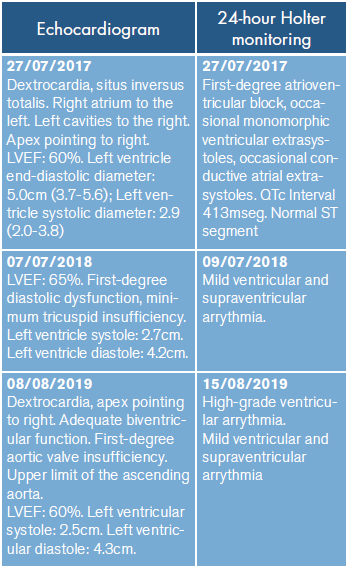
LVEF: left ventricular ejection fraction; QTc: corrected QT interval.
Source: Own elaboration.
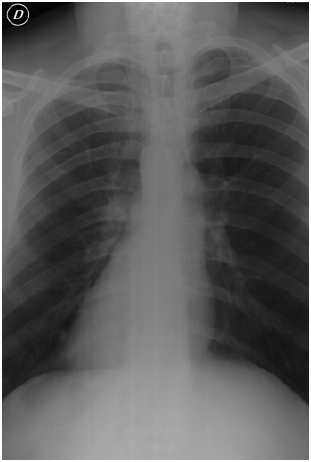
Source: Chest X-ray taken by health services. Obtained during the course of the study.
Figure 1 Anteroposterior projection of chest X-ray. Dextrocardia is clearly visible.
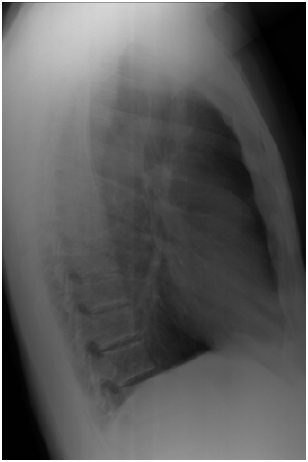
Source: Chest X-ray taken by health services. Obtained during the course of the study.
Figure 2 Lateral projection of chest X-ray.
10/09/2018: The patient reported dyspnea (functional class II/IV) and thoracic pain. Dextrocardia was discovered during clinical examinations. Etiological treatment for Chagas disease (benznidazole 5 mg/kg/ day for 60 days) was started and completed successfully. Treatment was temporally suspended for 5 days from day 12 due to gastrointestinal manifestations (severe nausea, vomit, and diarrhea) that limited his activities of daily living. He also experienced fatigue and weakness. The patient presented a pruriginous rash that was treated with antihistamines. Afterwards, treatment was continued without further complications. The patient lost 4kg due to the side effects of the treatment.
16/09/2019: The patient claimed that his condition had not worsened at the follow-up appointment. He had no pain and no further alterations in his functional class. No other member of his family has been diagnosed with Chagas disease. He has not acquired a new illness, nor has he undergone any extra therapies or procedures. His condition was defined as stable, with a favorable prognosis and a long-life expectancy. Furthermore, it was made clear that a lifelong follow-up was needed to avoid complications and further deterioration of his condition. The timeline of the case is presented in Figure 3.
Search strategies
PubMed, Scopus, SciELO, Redalyc, Lilacs, and Google Scholar were used to conduct the literature review. Five terms related to the patient's condition were combined in the search strategy: 1) Chagas disease, 2) Dextrocardia, 3) Humans, 4) Situs inversus, and 5) Situs solitus. The search included all studies conducted up until November 19, 2019, with no date restrictions.
Study selection and data extraction
Cases or series of cases of dextrocardia or situs inversus and Chagas disease with at least one patient were eligible for inclusion. If a study described a single case, it was classified as a case report, and if it described more than one patient, it was classified as a series. Publications not written in English, French, Spanish, or Portuguese were excluded. Two reviewers independently screened the search results for inclusion and extracted data using a standardized data extraction form. Disagreements were resolved through discussion until consensus was reached. Information about first author, country, year of publication, number of patients, sex, clinical manifestations, treatment, characteristics of the report and outcome was extracted.
Quality analysis
Each study was subjected to a quality assessment. To that end, both reviewers used a standardized data extraction form to extract the data. Coherence, findings, discussion, conclusion, the manner in which the case was reported, and diagnostic reasoning was evaluated.
The literature review yielded 230 studies (Figure 4) and 27 duplicates were removed. After screening titles and abstracts, 196 studies were excluded, for a total of 7 full texts evaluated. 3 of these studies met the inclusion criteria (Table 2). The 3 reported cases were female, with a mean age of 37.3+ 1.2. Dyspnea and syncope were the two most common symptoms. Table 3 shows other characteristics.
Table 2 Case reports included after the systematic search of literature.
| Ref. | Title | Year |
|---|---|---|
| 24 | Bloqueio atrioventricular total em dextrocardia e doença de Chagas: implante de marca-passo dupla-câmara com upgrade para estimulação biventricular | 2015 |
| 22 | Ablation of epicardial ventricular tachycardia in a Chagasic patient with situs inversus totalis: A case report | 2017 |
| 25 | Associação entre cardiomiopatia chagásica crônica e dupla lesão mitral reumática em uma paciente com situs inversus totalis | 2012 |
Source: Own elaboration.
Quality analysis results
Regarding the overall quality analysis, the results were fairly consistent. All the articles presented deficiencies in the reporting. However, follow-up and the use of different diagnostic aids were adequate in general. In general, however, follow-up and the use of various diagnostic aids were satisfactory. The studies omitted details about the patients' demographics, medical and family history, and most of them did not explain the timeline according to the CARE guidelines, although they are not a quality assessment tool. Discussions were relatively solid, but they could be improved and extended. Patients' perspective was not described in any of the cases, and there was no explicit information on the patient's informed consent in some of the reports.
DISCUSSION
Chagas disease is one of the most prevalent parasitic diseases in the Americas 27. The present article reported the case of a patient with dextrocardia associated with Chagas disease. To date, there is not much information available on this type of patient. Not only situs inversus totalis is a rare condition (2 cases per 10 000 are estimated in the United States) 21, but co-infection with Chagas disease seems to be even rarer. The literature search yielded only three cases, which are relatively similar to the one presented in this article, although they could be considered more severe due to the characteristics of the clinical manifestations and the treatment required.
On the other hand, the present case was the only one that clearly stated that the patient received etiological therapy for Chagas disease and reported a male patient. It stands out because it emphasizes the difficulties and challenges that this condition poses for establishing a treatment. There is no clear care standard for this specific kind of patient, side effects could be severe, and adherence is challenging due to such side effects and therapy length.
Still, it is important to use and complete the etiological treatment in patients with abnormal cardiac anatomy. The treatment reported here was not only necessary but also appropriate, as it minimized the likelihood of potential complications, which could be fatal in patients with anatomical abnormalities. In the event of side effects, therapy may be temporarily suspended, or other solutions considered.
As stated above, unlike the other cases found in the literature, the patient reported here is a male. When comparing this patient's clinical evolution and symptoms to those described by Craveiro et al.24, it was possible to establish that the clinical presentation of our case was not as severe, whereas his young female patient required the implantation of a peacemaker. Nonetheless, her evolution was equally satisfactory. Regarding the case published by Oliveira et al.22, which involved invasive procedures as treatment, she also had an adequate evolution. The last case 25 also had anatomical abnormalities that required other treatments and procedures to prevent complications and fatal outcomes.
As stated above, the findings of the overall quality analysis were relatively homogeneous. While these findings are similar to those reported in a study evaluating the consistency of evidence of acute outbreaks of Chagas disease, no other quality review of similar cases has been identified 7. The checklist used to evaluate the reviewed articles is not a quality assessment tool, which is a flaw in our approach to this case study 28. However, there was little knowledge on demographics, medical, and family history, and most of the cases lacked a timeline.
One difficulty of the quality analysis process was that there were several approaches. In a systematic review, Sanderson et al. 29 found 86 different tools, of which 48% were checklists, 38% scales, and 14% were summary judgement checklists. Moreover, some were created for general use, others for critical reading processes, and others were tools designed with a sole purpose in mind and can only be used in the original article. Since there are multiple tools, there is no consensus on their use 29. For example, the use of domains instead of checklists has been proposed by some organizations 30, especially as some checklist items are not justifiable and others are not related to quality or internal or external validity 30.
Finally, the strengths of this case report involve an extensive literature search, a thorough medical examination, the comprehensive assessment of the case, and the use of etiological treatment. In contrast, the weaknesses include the lack of additional blood and laboratory tests, and other imaging studies to assess more exhaustively the clinical condition of the patient, for example, to assess the possibility of situs inversus totalis.
CONCLUSION
This case highlights the importance of adequately approaching and treating patients with two conditions that can affect the cardiovascular system in particular and the whole anatomy in general. While this patient received sufficient follow-up, complications and challenges in this area are still a possibility and could hinder the comprehensive assessment of patients.













